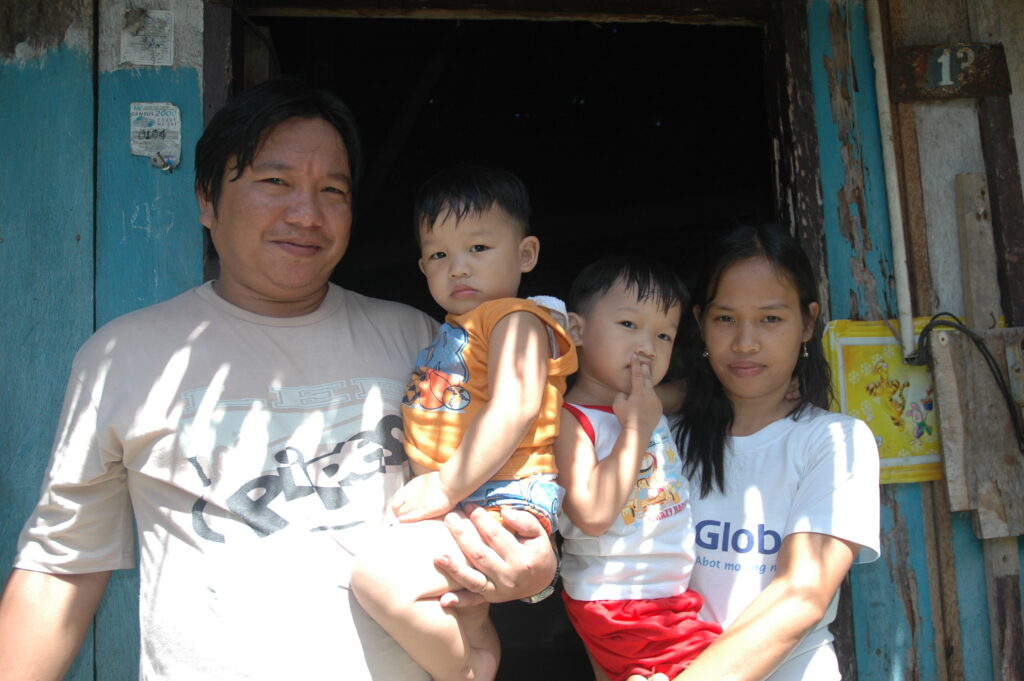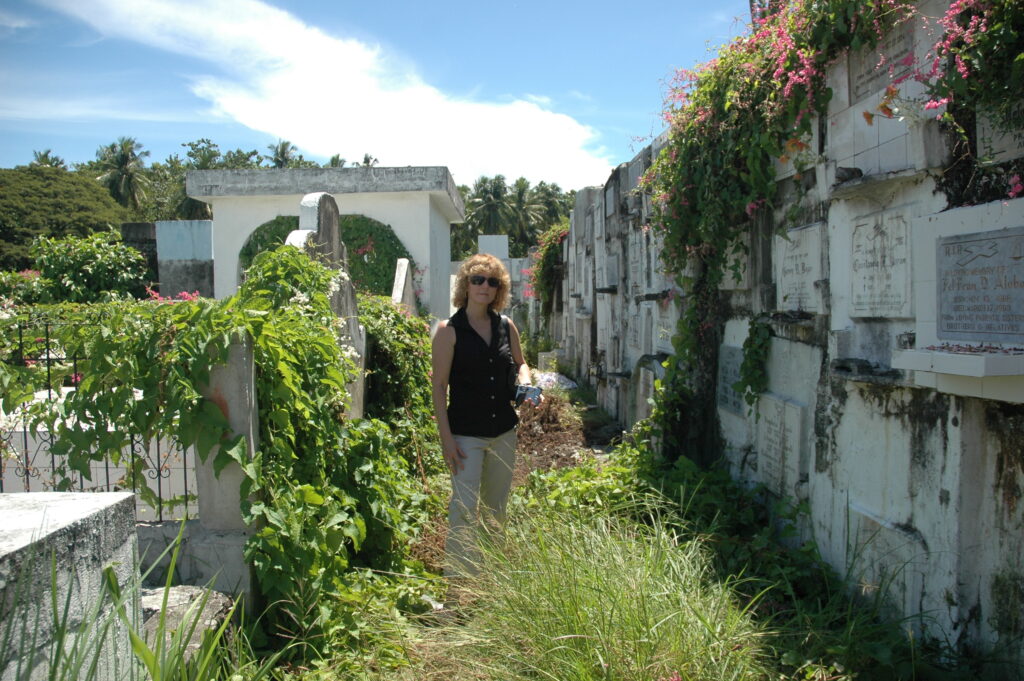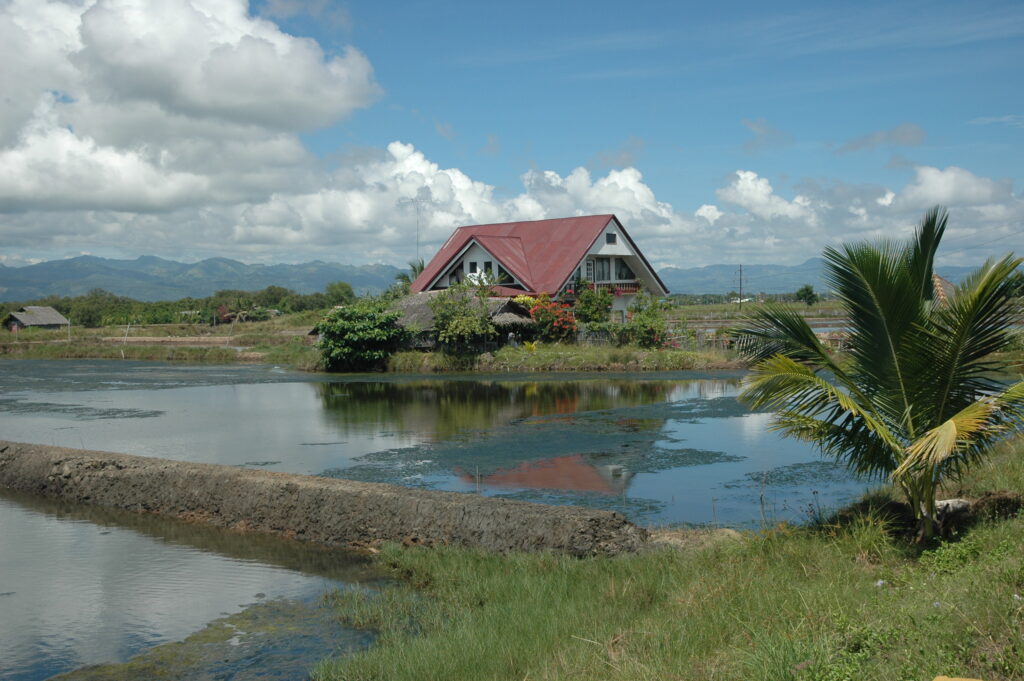
Time to wrap up this amazing trip. On Sunday, October 19, we were still in Dumaguete, a small town on the island of Negros. Today was our day to visit patients in their home, always the highlight of my trips. The weather was brilliantly sunny, blue skies and 100% humidity. The ride was brief, as the patients we visited were close by. First was the home of Raynold Bilandal, two years old, factor VIII deficient. A chubby, well cared for child, he lives in poverty materially, but in love richly. Their house sits back a bit from a main road; it’s open and airy, with no screens to filter out mosquitoes. They own little: simple beds, a table, a cassette player for the treasured music Filipinos love, a pet parakeet. This is a family with many members who have hemophilia: brothers, uncles, and many children who have already died. We enjoyed our visit very much, and took photos for Raynold’s sponsor, Joe Cardoza, son of Save One Life’s executive director.
Our next home was in Tanjay City, a small village, to see three patients who are enrolled in Save One Life: Carymar, Reymark and Jhon. We waked through the village, garnering stares from the villagers, and soon a following behind us as the children whispered about the foreigners in their midst. We saw a man getting a shave in the open air by his neighbor, chickens and roosters scuttling about, washing being hung to dry and water being pumped from a well. The ground was thick with mud so we stayed close to the stones that formed a walkway; I noticed deeply embedded coral in the ground, wondering if this was once an ocean floor? First we came to Jhon’s house, with its bamboo walls, thatched roof, and mud floor entrance. Jhon is doing fairly well, and is being raised by his grandmother, a spry elder woman (seen being interviewed in the photo by Andrea Trinidad-Echavez). As we spoke with Jhon, the crowd swelled; some were family members, and others were neighbors. Jhon attends school, and uses Save One Life funds to get medical treatment.



Next door practically is his cousin Carymar. Several family members live in his house. They have the basics: beds, kitchen, a TV. But they are very poor. This was a special day: Carymar’s 19th birthday! We sang happy birthday to him as we interviewed his family about how they are doing with the Save One Life program. They are all deeply appreciative of the help.


After the visits, we decided to go to the local cemetery, to seek out the graves of Jeffrey’s four brothers. If you recall, Jeffrey is a 21-year-old from Manila we met, who is in college studying psychology. He wants to be a therapist for the young men with hemophilia in the Philippines. His ambition derives from the pain he experienced losing four of his brothers to hemophilia. He himself rarely is able to afford to travel all the way to Dumaguete to see the graves. We promised him we’d find them and then email the photos.
Easier said than done. The graves are above ground mostly, a la New Orleans, and stacked, creating a maze of graves and tombs that are not registered in any fashion. We had to walk for over an hour in about 95-degree heat to find them. The cemetery was not maintained and so vines and plants covered the tombstones and markers. We walked along, reading the names: Torres, Ramirez, Rodriquez. No luck. Three young boys followed us, and soon we paid them to start clearing away the undergrowth to read the graves and find the ones we wanted. Finally, we located them. We called Jeffrey who was really touched at our persistence. We paused a moment in prayer, to acknowledge the suffering these graves represent: hemophilia boys and men who will never complete their lives, who died only from lack of affordable treatment. For while there is rarely factor to purchase, even FFP and cryo is too expensive for most Filipinos to afford. Early death is a constant here.


As we left, we had one humorous moment when we spied three goats, tied up in the broiling sun to three graves, left for the day by the owners to nibble away the grass. Third World lawnmowers.
On Monday, October 20, we headed out by Ocean Jet (2.5 hours), and then by car (3.5 hours) to Ozamiz City, on the large island of Mindanao. We were deep into Philippine countryside now, and I was constantly started at. Not many westerners make it down here, I gather. The scenery is gorgeous: rice fields carpeting the landscape, hemmed in by towering mountains. The sky is most dramatic here: from the Ocean Jet, the clouds roiled up like white cotton dolphins leaping out of the liquid blue. Water buffaloes plod in rich mud, their hoofs sucking with each step as they plough.
See photos of the entire trip here.
On Tuesday I awoke with a startling surprise: 27 bug bites on my face. My eyes were half closed in reaction, my skin covered in welts. Just lovely. Apparently I had accidentally left the screen door open all night in the bathroom, and the mosquitoes had a midnight buffet. I was a bit worried as malaria and dengue fever are widespread here, but so far so good.
Despite my appearance, Tuesday was the climax of the trip for me, because I visited my child, whom I sponsor. Kent Tan is a darling boy, living in a rural community, some two and a half hours from Ozamiz City. His parents were so grateful for our efforts to visit. He lives in a small but clean home with his parents, and brother Karl, sponsored by my friend Kyle Callahan (who also has hemophilia). Karl as just getting over a leg bleed, with factor we had donated. Both boys look in great shape! His mother, Hydeeh, stays home with both boys. The father Juderick, only earns $100 a month, not enough to pay for medical treatment for two boys with hemophilia. The use their Save One Life money as a savings account, in case of medical emergency. Kyle and I give them $40 a month combined, which is an additional 40% of their monthly income. You can see how well Save One Life helps! The parents are very smart about how to use their finds. When I aksed them what else I could do for them, they very humbly declined to ask for anything more, counting their blessings.
I have so much more to write about this amazing trip, but the hour is late and I have severe jet lag. And a busy week coming up! If you’d like to read in depth about the trip, please go to the Save One Life website, where we will post our newsletter OneVoice, in a few weeks. The November issue will feature the trip, and will have more photos. Also, I will post photos from the trip as soon as I complete labeling them, in about a week.
Our trip took us to six cities in 12 days, by car, speedboat, ferry and airplane. I’ve logged in hours by each, seeing the tropical countryside, quaint villages, busy hospitals, magnificent churches, and homes of the poor. Father Don has been an excellent host and traveling partner, displaying deep compassion but logical analysis and a desire to improve the lives of those with hemophilia, a mission that goes above and beyond whatever job description he has as a Columban priest. I was privileged to visit the home he maintains in Ozamiz City, where he houses 26 teens from impoverished backgrounds, who are now attending high school or college, and who will all have a promising future. Hemophilia is “just” a moonlighting mission for the indefatigable Father Don! God bless him for that: these patients need every angel they can.

This has been one of the most amazing trips I have ever taken, from the sheer beauty of the Philippines, to the devastating poverty and suffering that stalks each hemophilia patient like a predator, waiting to pick off unlucky victims. I don’t know why, but I have never seen such wide scale effects of untreated hemophilia: joint crippling, pseudotumors, intracranial bleeds, loss of life and amputations. The Philippines is in dire need of help. One way to help is to support individual patients so they can have the funding needed to get to the hospital, or to buy cryo of FFP, or even factor. Please consider supporting a person with hemophilia from the Philippines. We will enroll all the new patients we have met. Just $20 a month can change their lives! I know they have forever changed mine.
Salamat (thanks) to Father Don Kill, the Columban MIssions for housing me in the Philippines, to HAPLOS, to the dedicated physicians we met, and to our skilled and patient driver Honorato!


4 thoughts on “Philippine Journal: Day 12”
In the 80’s when it was discovered that Factor could be produced in cell cultures, we were told that Factor could be economically mass produced for less than the price of cryo ( then about 10 cents per unit, I think). What went wrong?
Great question. Pricing is complicated to explain, but the best and simplest explanation is that the price reflects what the market will bear. This is not regular economics: this is an oligopoly model, with a few producers selling to a captive, small and well defined market. As long as the market keeps paying, prices will stay where they are. There is littel incentive to sell at a mass discount to the developing countries. The manufacturers do give away millions of units of factor, primarily I think to those in the developed countries who find themselves temporarily uninsured. And they do donate to the WFH but at a greatly reduced amount from the heydays of the “shortage” when manufacturers ramped up production believing the shortage would continue. Now there is no shortage, tight supplies and much fewer donations.
Good day. I am a concerned individual living in Marikina City, Philippines. I have a friend who has Hemophilia B since his birth. He used to share me some information about hemophilia. He told me that a factor IX concentrate is the one needed to help Hemophilia B patients. Unfortunately, it is not easy to find suppliers of factor IX concentrate. Also, their organization, the HAPLOS foundation, is having a hard time to seek support from other private institutions.With this, I wonder if your company could extend your helping hand to this foundation to be able to support hemophilia patients here in the Philippines. I know this is so informal but I am just a simple individual who aims to help my friend and their foundation. I can’t find any other way to help them.I am hoping for a warm response from your office regarding this matter. I hope you could help the hemophilia patients here in the Philippines. Please do send your reply to ronwaldo.reyes@yahoo.com. Thank you very much and God bless.
The South African Haemophilia Nurses’ Training course is perfect for nations like the Phillipines as it trains nurses to recognise and maintain haemophilia care. It is particularly appropriate to regional areas with poor infrstructure as the nurse is on the spot and can communicate with HTCs if she/he needs to. I went to Cambodia last December to help them run a course based on the SA model and it came off well. I’ve not had feedback yet about outcomes but the participants were very enthusiastic. Some of that was because I suspect that they are not exposed to much outside teaching. I think this might be the case in many developing nations, so is perhaps something that could be exploited for haemophilia and your work with chronic disorders. If the teaching for haemophilia care is the first the staff are exposed to, they are going to naturally have greater awareness of that particular disorder and be more likely to act on it. I would be happy to explore this idea further if you think it has value. Jill Smith, nurse, Royal Perth Hospital, Australia